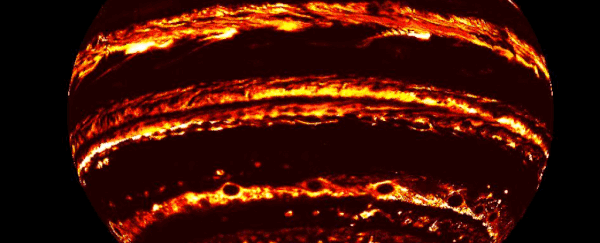Just when we thought we had Jupiter all figured out, NASA's Juno spacecraft reveals new results that challenge almost every assumption we've made about the gas giant.
The first results from Juno's initial two flybys back in August 2016 describe giant cyclones, a super powerful magnetic field, and weird northern lights that behave totally different to our own.
The discoveries were made when the basketball court-sized spacecraft swooped within 5,000 kilometres (3,106 miles) of the cloud tops, and drifted over the planet's poles.
"What we've learned so far is Earth-shattering. Or should I say, Jupiter-shattering," said Juno's principal investigator at the South Research Institute, Scott Bolton. "Discoveries about its composition, magnetosphere, and poles are as stunning as the photographs the mission is generating."
After its arduous five-year journey from Earth, Juno finally locked into Jupiter's orbit in July 2016 to catch a closer glimpse at what lies within the planet's swirling clouds.
The probe captured some mind-blowing first images of Jupiter's giant oval-shaped storms around the north and south poles. It also recorded some eerie sounds when it careened into the planet's enormous magnetosphere, which contracts and expands according to solar wind movements.
 NASA/JPL-Caltech/SwRI/MSSS/Betsy Asher Hall/Gervasio Robles
NASA/JPL-Caltech/SwRI/MSSS/Betsy Asher Hall/Gervasio Robles
But the spacecraft didn't travel 2.8 billion kilometres into space to take pretty pictures and record weird noises. Juno's real mission has been to create a detailed map of the gas giant, which will help scientists learn more about how our Solar System's planets, including Earth, formed around 4.5 billion years ago.
The probe also collected data on Jupiter's inner structure, atmosphere and magnetic field with its eight instruments.
The first study, led by Bolton, describes the massive storms and cyclones clustered around Jupiter's previously unseen poles. The images revealed chaotic oval-shaped features that are completely different from Saturn's polar regions.
When the researchers created a time-lapse of the images, they discovered that these swirling ovals were gigantic cyclones.
Some of these mammoth cyclones reached up to 1,400 kilometres (900 miles) wide - 10 times larger than Earth's biggest cyclones. The storms also reached close to 100 kilometres high - up out of Jupiter's atmosphere.
But the real surprise came from beneath the clouds, when Juno measured the thermal structure of the Jovian atmosphere.
When the probe beamed microwaves into the deep atmosphere, the data showed signs of strange ammonia plumes welling up from the equator, forming giant weather systems that extend well beneath the cloud tops.
"It resembles a deeper, wider version of the air currents that rise from Earth's equator and generate the trade winds," said Bolton.
Things got even weirder in the second study, when Juno took a closer look at Jupiter's magnetic field - the largest object in the Solar System.
While researchers were well aware of the power and enormity of Jupiter's magnetic field, they were surprised to find that it was twice as strong as the models predicted.
Measuring at 7.766 Gauss, the region the spacecraft examined was 10 times more powerful than Earth's magnetic field, which sits at a mere 0.66 Gauss at the South Pole.
The magnetic field is also more dynamic than previously thought, with an uneven, patchy distribution.
Speaking to ScienceAlert, Juno's deputy lead investigator, Jack Connerney, said that the planet's lumpy magnetic field indicates that it may originate from processes close to the planet's surface.
This is vastly different to Earth's magnetic field, which is stemmed from the hot liquid iron core deep below the crust.
"The magnetic field appears to have a much richer spatial variation than what we were expecting based on what previous spacecraft had found," Connerney, who led the second study, told ScienceAlert.
"The most exciting thing about studying Jupiter is that, compared to Earth, we get a more detailed view of how magnetic fields work."
Taking a closer look at the magnetosphere - the space around a planet that is controlled by the magnetic field - revealed yet another surprise.
When Juno passed through the magnetosphere in June 2016, it encountered the planet's bow shock - a shock wave that occurs when the magnetic field begins redirecting the solar winds away.
But the probe only passed through one bow shock compared to the many it encountered on other orbits. Connerney said that this is because Jupiter's magnetosphere was expanding at the time of Juno's approach.
"The bow shock varies in its distance from Jupiter, expanding when the solar wind is weak or slow, and contracting when the solar wind is strong," said Connerney.
Stranger still were Jupiter's stunning violet-blue aurorae, which were detected by Juno when it hovered over the poles.
 J.E.P. Connerney et al., Science (2017)
J.E.P. Connerney et al., Science (2017)
On Earth, the Northern and Southern lights occur when charged particles from the solar wind are funnelled down through the magnetosphere into the polar regions.
Connerney and his colleagues thought Jupiter's light-show was due to a similar downward flow of electrons pouring into the Jovian atmosphere.
But Juno's instruments revealed a whole other story. The Jovian aurorae are powered by the electrons being sucked out of the planet's polar region, which basically means that Jupiter powers its light-show all on its own.
"It's a 180-degree reversal of what we were originally assuming," Connerney told ScienceAlert. "We never expected to see such strong auroral emissions caused by electrons being channelled out of the polar region."
And all of this is just the beginning. Juno has completed 5 out of 33 flyby investigations on its mission to map the giant of the Solar System.
Its next flyby will take a look at the iconic Great Red Spot on July 11, where it will unravel more of the planet's weird wonders.
The two studies were published today in a special edition of Science. You can find them here and here.
